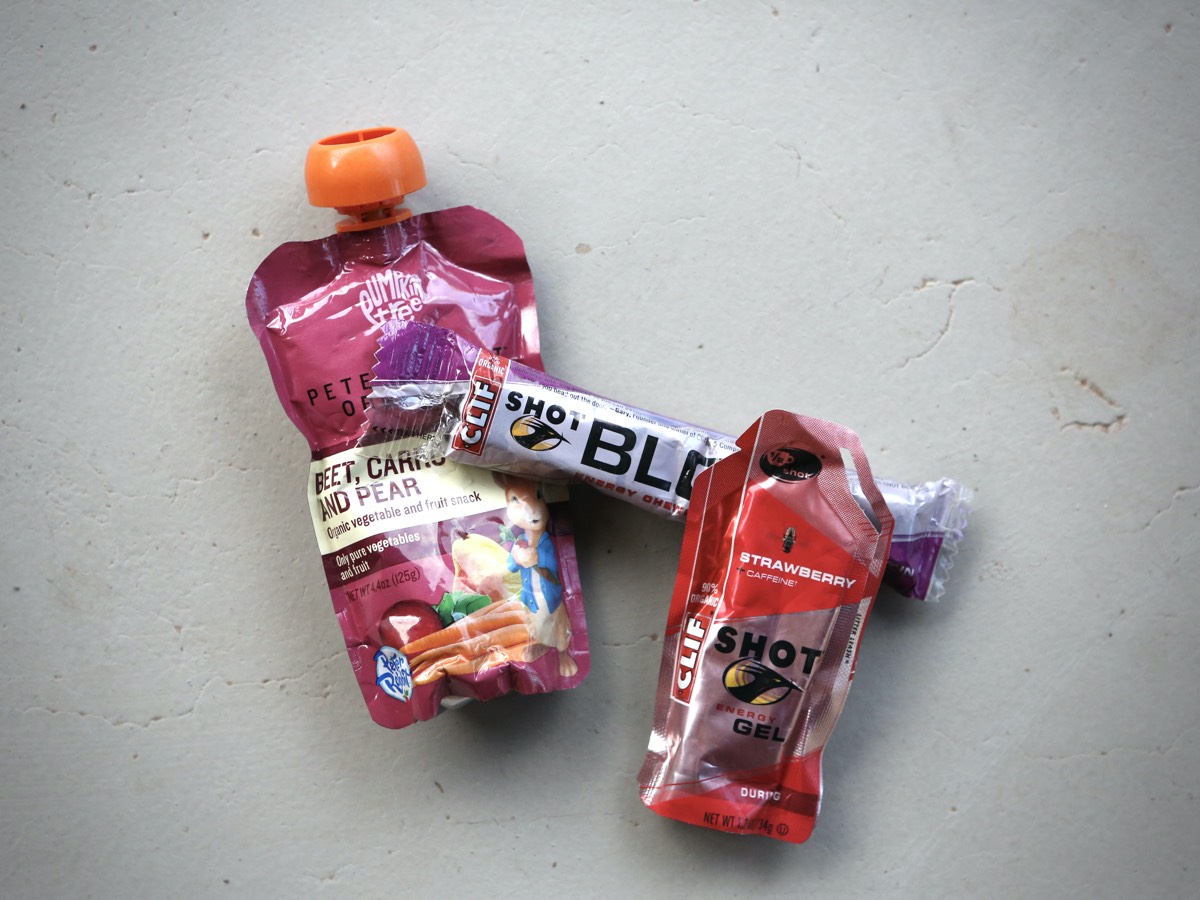
Like this article? Get your copy of the book “Where the Road Ends!”
Welcome to this month’s edition of “Where the Road Ends: A Guide to Trail Running,” where we discuss the basics of trail running fueling. “Where the Road Ends” is the name of both this column and the book Meghan Hicks and Bryon Powell of iRunFar published in 2016. The book Where the Road Ends: A Guide to Trail Running is a how-to guide for trail running. We worked with publisher Human Kinetics to develop a book offering the information anyone needs to get started, stay safe, and feel inspired with their trail running. The book Where the Road Ends teaches you how to negotiate technical trails, read a map, build your own training plan, understand the basics of what to drink and eat when you run, and so much more.
This column aims to do the same by publishing sections from the book as well as encouraging conversation in the comments section of each article. We want you to feel inspired and confident as you start trail running as well as connected to iRunFar’s community of off-road runners!
In this article, we excerpt from Chapter 6 to talk about the basics of trail running fueling.
Why is Fueling While Trail Running Important?
Stephanie Howe has a master’s in exercise physiology and a PhD in nutrition and exercise physiology, and she was the winner of the 2014 Western States 100. She starts with the basics: “Carbohydrate, fat, and protein are the macronutrients that provide our bodies with energy. We need all three nutrients to survive and to optimize performance. For an endurance athlete, an ideal nutrient profile includes 55 to 65 percent carbohydrate, 20 to 30 percent fat, and 10 to 30 percent protein. The exact amounts required depend on the individual (gender, training level, fitness, genetics, and so on), but the basic framework remains the same.”
Our bodies tap carbohydrate reservoirs as well as fat dispersed throughout the body as fuel for endurance exercise. (The body also consumes muscle protein as a fuel source during endurance exercise at an extremely low rate. Because of that low rate, we leave it out of our basic fueling equation.) Explains Howe, “First, we have stores of carbohydrate—glycogen—in the muscles and the liver. When we start activity, the body begins to use this stored glycogen for energy. Around 90 minutes or so, the amount of stored glycogen begins to dwindle, and the body turns to another source, blood glucose, to supply energy to the working muscles. This strategy works only for some time because the amount of glucose we’re using is not replenished fast enough (by gluconeogenesis in the liver) to prevent a decline in blood glucose. Blood glucose is closely monitored by the brain and maintained in a narrow physiologic range, and fatigue sets in after it starts to decline.”
The body can convert massive amounts of fat for endurance exercise, and even runners with very low body-fat percentages have many thousands of calories of usable fat. Because our bodies differ, the amount of carbohydrate and fat that your body stores and is able to convert varies.
In running, the average human body calls on those energy stores at a rate of about 100 calories per mile (60 calories per kilometer). At moderate to high heart rates, the body draws significantly on its glycogen stores and more minimally on fat. At lower heart rates, the body uses smaller amounts of glycogen and a lot of fat. You can run at higher heart rates until you deplete your accessible glycogen. Unless you are consuming carbohydrate-based running fuel, you will have to slow to a lower heart rate, but you will still be able to run using your fat stores. To prevent that slowing, we take in fuel during prolonged exercise.
In the rest of this article, we learn the basic principles of fueling immediately before, during, and after your trail runs, as well as how to adapt these ideas to your body’s unique needs.
Six Fundamental Concepts of Trail Running Fueling
These are the six basic concepts for fueling before, during, and immediately after trail running:
- Properly fuel on a daily basis, not just when you’re running. Make sure that your calorie intake roughly matches your calorie expenditures. Eat a variety of whole, unprocessed foods as much as possible.
- Eat a small meal containing foods you know you can digest two to three hours before a long trail run. Consume 100 calories of a carbohydrate-based, easily digestible food source 15 to 30 minutes before beginning a long trail run.
- In many circumstances you don’t need to fuel during a run, such as a two-hour run during which you can rely entirely on your body’s energy stores.
- On long runs where you need to ingest fuel, consume 200 to 300 calories per hour of fuel designed for consumption during aerobic exercise. Avoid consuming much more than 100 calories at once and try to space those calories over the entire hour. Howe says, “Fueling should begin within the first 60 minutes and continue at regular intervals throughout exercise. Normally a feeding schedule of every 20 to 30 minutes is ideal to supply a steady stream of energy and prevent stomach distress (by maintaining blood flow to the gut, rather than a large bolus of fueling with long periods in between).”
- Consume 150 to 300 calories of your preferred recovery fuel in the first 30 minutes after a long or hard trail run.
- Be safe! If you’re headed to a remote place or if the weather is bad, carry plenty of food as part of your safety plan.
Fueling Before Trail Running
If you’ve eaten a regular meal within 12 hours or so of a run without having exercised much, your muscle glycogen stores will be full. But the glycogen stores in your liver vary from hour to hour. Thus, the purpose of a pre-run meal is to restore the glycogen in your liver to its maximum capacity.
So, eat a meal containing 100 grams (400 calories) of carbohydrate two to three hours before your run. This interval is enough time for your stomach to absorb the food and convert it to liver glycogen. This should also be enough time for any insulin-level changes to occur and return to normal, which affects how fast you burn through that liver glycogen.
Many experts also recommend a small dose of glucose in the 15 to 30 minutes immediately before starting a run. This fuel can come from a sports nutrition product.
Fueling While Trail Running
As noted, you don’t need to put energy into your body before or during your run unless you’re planning to burn through your body’s accessible glycogen stores. And even after that, you could keep going much farther at a slower pace using your body’s fat stores.
But if you are planning to run long and fast enough to expend your accessible glycogen stores and you would like to keep running at that pace, you will need to fuel. You are limited, however, by what your stomach can process. Shoot for up to 300 calories per hour if you are running at an easy or moderate effort. If you’re pushing hard, you might be limited to processing 200 or even 150 calories per hour because blood flow shifts from your stomach to the muscles you’re using to run. Most of your calories should come from easily digested, high-carbohydrate foods.
For maximum performance, Howe says to consume multiple carbohydrate sources, namely glucose through maltodextrin and fructose at a ratio of two to one. If you are consuming maltodextrin, your body can process about 60 grams (240 calories) of it per hour. But if you consume fructose along with maltodextrin, notes Howe, your total carbohydrate absorption rate increases to 75 grams (300 calories) per hour. When you combine carbohydrate sources, such as by simultaneously ingesting both maltodextrin and fructose in that ratio, says Howe, the rate of absorption will increase and you will have the lowest risk of stomach distress.
Many fueling sources are available, from sports gels and blocks to cookies, from carbohydrate-laden sports drinks to fruit juice, and others. Test a number of products to see how they make your energy level and stomach feel as you run. Runners who have sensitive stomachs or who plan to fuel while running at a decent effort may find that their stomachs tolerate run-specific fuels better.
Running fueling is an experiment of one. Your stomach will tell you what it likes and what it can process per unit of time. Its ability to process foods while running varies according to how fast you’re running, what the weather is, how well you’re accustomed to eating while running, and more.
Fueling after Trail Running
“Nutrition in the post-exercise period is critical for recovery [after long or hard runs],” begins Magda Boulet, an Olympic marathoner turned ultrarunner who works in research at Gu Energy and who has a master’s in exercise physiology. “Your recovery meal should include quality protein to maximize protein synthesis rates, speed recovery, and promote muscle repair. As important, the consumption of carbohydrate will maximize glycogen synthesis to prepare for the next workout.”
To elaborate, your body has an increased capacity for synthesizing carbohydrate back into your muscles and liver in the 30 to 60 minutes immediately after exercise. If you’ve gone on a run during which you’ve depleted a significant amount of your body’s glycogen stores, use this window to replenish. Make sure that your recovery fueling also includes some protein to help repair muscle tissues stressed by your exercise and to replace the small amount of protein you burned as fuel. Today, many recovery products are available, typically powders of easily digestible carbohydrate and protein that you mix into water before drinking. But many people refuel with readily available food and drink that are rich in carbohydrate and contain a modest amount of protein. Pick what tastes good and what your body responds to best.
Excerpted from Where the Road Ends: A Guide to Trail Running, by Meghan Hicks and Bryon Powell. Human Kinetics © 2016.
To learn more about fueling and running, check out our deep-dive article.
Call for Comments
- For those who have successfully fueled while running, can you share an example of what you ate and how you ate it?
- And, how about a story from when your running nutrition didn’t go well and either your energy level lacked or your stomach was upset? What happened?
- If you are just getting started in trail running, what specific fueling questions do you have? Leave a comment to start a discussion.


